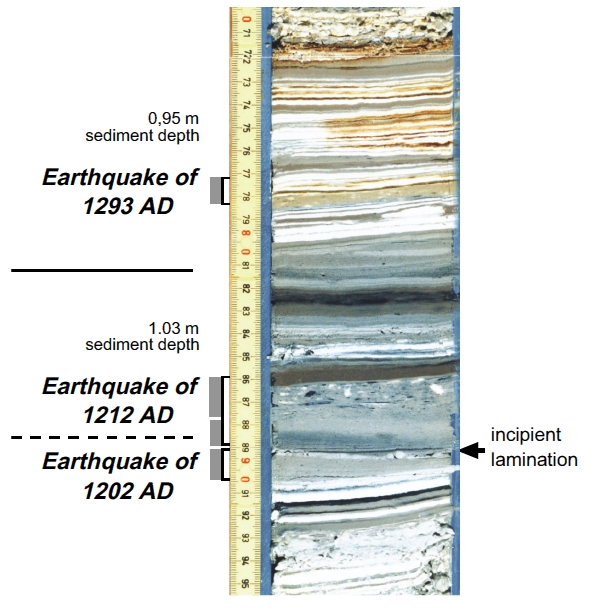| Jordan Valley - Tell Saidiyeh and Ghor Kabed Trenches |
possible |
≥ 7 |
Ferry et al (2011) detected 12 surface rupturing seismic events in 4 trenches (T1-T4) in Tell Saidiyeh and Ghor Kabed; 10 of which were prehistoric. The tightest chronology came from the Ghor Kabed trenches
(T1 and T2) where Events Y and Z were constrained to between 560 and 1800 CE. |
| Dead Sea - Seismite Types |
n/a |
n/a |
n/a |
| Dead Sea - En Feshka |
possible |
8.2 - 9.0 (0 cm.)
8.1 - 8.9 (12 cm.)
8.0 - 8.8 (28 cm.) |
Kagan et. al. (2011)
identified several seismites from around this time.
| Depth (cm.) |
Thickness (cm.) |
Seismite Type |
Modeled Age (± 1σ) |
Modeled Age (± 2σ) |
Quake Assignment (Kagan) |
Quake Assignment (Williams) |
| 0 |
10 |
4 |
1322 CE ± 22 |
1350 CE ± 71 |
Kagan et. al. (2011) assigned a date of 1312 CE based on an erroneous catalog entry from Ben-Menahem which is a duplicate
of the 1212 CE Quake |
not assigned |
| 12 |
7 |
4 |
1277 CE ± 17 |
1303 CE ± 64 |
1293 CE Quake |
1293 CE Quake |
| 28 |
2 |
4 |
1220 CE ± 21 |
1222 CE ± 46 |
1202 CE Quake and 1212 CE Quake |
not assigned |
|
| Dead Sea - En Gedi |
possible |
7.9 - 8.8 |
Migowski et. al. (2004)
assigned a 1293 CE date to a 1 cm. thick Type 4 seismite at a depth of 94.81 cm. (0.9481 m). |
| Dead Sea - Nahal Ze 'elim |
possible |
8.3 - 9.1 |
At site ZA-1, Ken-Tor et al (2001a)
assigned a a date of 1293 CE to a ~15 cm. thick Type 4 seismite
which they labeled as Event F and was dated between 1270 and 1400 CE (± 2σ). In Table 4 of Kagan et. al. (2011), a 16 cm. thick
seismite at ZA-1 was associated with the 1293 CE earthquake. At site ZA-2, Kagan et. al. (2011)
did not find any seismites whose time window encompassed 1293 CE. |
| Araba - Introduction |
n/a |
n/a |
n/a |
| Araba - Taybeh Trench |
possible |
|
LeFevre et al. (2018) assigned a 1293 CE date to a seismite labeled as E3supp (aka E3bis) which was age
modeled to between 819 and 1395 CE. |
| Araba - Qatar Trench |
possible |
≥ 7 |
Klinger et. al. (2015) identified one seismic event which might fit.
| Event |
Mean Date |
Age Range |
Quake Assignment (Klinger) |
Quake Assignment (Williams) |
| E2 |
1212 CE ± 57 |
1155-1269 CE |
1212 CE Quake |
not assigned |
|
| Araba - Taba Sabhka Trench |
possible |
≥ 7 |
Allison (2013)
assigned a 1068 CE date to a seismic event which they dated to between 1045 and 1661 CE and
Allison (2013)
assigned a 1212 CE date to a seismic event which they dated to between the mid 11th century CE and the 16-17th centuries CE. |
| Araba - Elat Sabhka Trenches |
possible |
|
Kanari et al (2020) suggested that a dewatering structure
(aka a liquefaction fluid escape structure) found in Trench T1 and dated to before 1269-1389 CE was caused by the
1068 CE Quake(s) or the
1212 CE Quake. Kanari et al (2020)
also dated Event E2 in Trench T3 to after 1294 CE and assigned it to earthquakes in 1458 or 1588 CE. Kanari et al (2020) dated
sand blows SB1 and SB2 in Trench T3 to between 1287 and 1635 CE and suggested they may have formed during an earthquake in 1458 CE.
|
| Araba - Trenches in Aqaba |
possible |
≥ 7 |
Niemi (2011:153) noted that the most recent scarp-forming event fault [in Trench AQ-1]
occurred after A.D. 1045-1278 based on a corrected,
calibrated radiocarbon age from charcoal collected
from a buried campfire at the base of the scarp in
Trench T-1. This likely represents fault motion in one
of the historical earthquakes affecting southern
Jordan (e.g. 1068, 1212, 1458, or 1588). |
